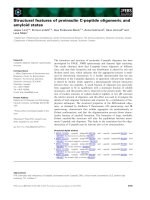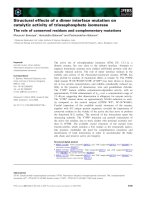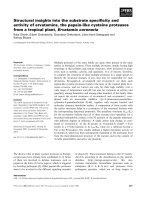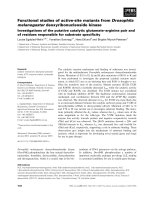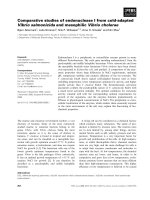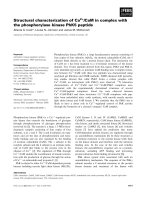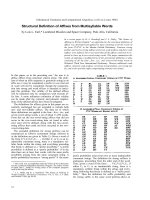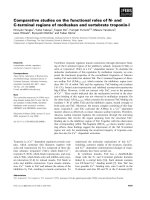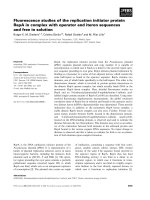Báo cáo khoa học: Structural studies of the capsular polysaccharide and lipopolysaccharide O-antigen of Aeromonas salmonicida strain 80204-1 produced under in vitro and in vivo growth conditions docx
Bạn đang xem bản rút gọn của tài liệu. Xem và tải ngay bản đầy đủ của tài liệu tại đây (241.29 KB, 10 trang )
Structural studies of the capsular polysaccharide and
lipopolysaccharide O-antigen of
Aeromonas salmonicida
strain
80204-1 produced under
in vitro
and
in vivo
growth conditions
Zhan Wang
1
, Suzon Larocque
1
, Evgeny Vinogradov
1
, Jean-Robert Brisson
1
, Andrew Dacanay
2
,
Marshall Greenwell
2
, Laura L. Brown
2
, Jianjun Li
1
and Eleonora Altman
1
1
Institute for Biological Sciences, National Research Council of Canada, Ottawa, Canada;
2
Institute for Marine Biosciences,
National Research Council of Canada, Halifax, Canada
Aeromonas salmonicida is a pathogenic aquatic bacterium
and t he causal agent of furunculosis in salmon. In the course
of this study, it was found that when grown in vitro on
tryptic soy agar, A. salmonicida strain 80204-1 produced a
capsular polysaccharide with the identical structure to that
of the lipopolysaccharide O-chain polysaccharide. A com-
bination of 1D and 2 D NMR methods, including a series of
1D analogues of 3D experiments, together with capillary
electrophoresis-electrospray MS (CE-ES-MS), composi-
tional and methylation analyses and specific modifications
was used to determine the structure of these polysaccharides.
Both polymers were shown to be composed of linear
trisaccharide repeating units consisting of 2-acetamido-
2-deoxy-
D
-galacturonic acid (GalNAcA), 3-[(N-acetyl-L-
alanyl)amido]-3,6-dideoxy-
D
-glucose{3-[(N-acetyl-
L
-alanyl)
amido]-3-deoxy-
D
-quinovose, Qui3NAl aNAc} and 2-ace-
tamido-2,6-dideoxy-
D
-glucose (2-acetamido-2-deoxy-
D
-
quinovose, QuiNAc) and having the following structure:
[fi3)-a -
D
-GalpNAcA-(1fi3)-b-
D
-QuipNAc-(1fi4)-b-
D
-
Quip3NAlaNAc-(1-]
n
, where GalNAcA i s partly presented
as an amide and AlaNAc represents N-acetyl-
L
-alanyl
group. CE-ES-MS analysis of CPS and O-chain polysac-
charide confirmed that 40% of GalNAcA was presen t in the
amide form. Direct CE-ES-MS/MS analysis of in vivo cul-
tured cells confirmed the formation of a novel polysaccha-
ride, a structure also formed in vitro, which was previously
undetectable in bacterial cells grown w ithin implants in fish,
and in which GalNAcA was fully amidated.
Keywords: Aeromonas salmonicida; capsular polysaccharide;
lipopolysaccharide; NMR.
Aeromonas salmonicida is the aetiological agent of fu runcu-
losis in s almonid fish, a disease which causes high mort alities
in aquaculture. Considerable effort has been devoted to the
development of e ffective vaccines a gainst furunculosis.
Known extracellular virulence factors of the in vitro-grown
A. salmonicida include surface layer (A-layer) [1], proteases
[2], haemolysins [3], type IV pili [4] and LPS [5]. Very little is
known about the role of these factors in vivo and their role in
furunculosis. The A-layer is believed t o play a crucial role
in the bacterial protection against c omplement-mediated
killing in vitro and contributes to bacterial survival in
phagocytes or host tissues [6]. In addition to the A-layer,
lipopolysaccharide (LPS) is another at least partially
exposed cell surface antigen that a ppears t o m ediate
invasion [7]. Mo noclonal and polyclonal antibody analysis
of a variety of A. salmonicida strain s h as shown that like the
A-layer, the surface-exposed regions of LPS are antigeni-
cally cross-reactive [8]. Formation o f capsular polysaccha-
ride (CPS) covering the A-layer has been reported to be
produced during the in viv o culture of A. salmonicida in
surgically implanted intraperitoneal culture chambers [9].
Moreover, Merino et al . [10] have reported that when
grown under c onditions promoting c apsule formation,
strains of A. salmonicida exhibited s ignificantly higher
ability to invade fish cell lines. It suggests that, as with the
A-layer and LPS, CPS is an important virulence factor,
essential for host cell invasion and bacterial survival.
Previous studies have determined the structure of the
O-chain polysaccharide of A. salmonicida strain SJ-15 [11].
Partial structure of the core oligosaccharide from the same
strain of A. salmonicida was also determined [12]. In both
instances A. salmonic ida strain SJ-15 was cultured in tryptic
soy broth (TSB) at 25 °C. In addition, other reports des-
cribe capsular material isolated from cells grown on yeast
extract-peptone-glucose-mineral salts [13]. The relevance of
these structures to in vivo-cultured bacteria and their role in
pathogenesis has not been established.
In the present study we have isolated and c haracterized
the cell-surface carbohydrate antigens of A. salmonicida
Correspondence to E. Altman, Institute for Biological Sciences,
National Research Council of Canada, Ottawa, Ontario,
K1A OR6, Canada. Fax: +1 613 941 1327, Tel.: +1 613 990 0904,
E-mail:
Abbreviations: A-layer, Ae r omonas surfa ce layer; CE- E S-MS, capillary
electrophoresis-electrospray MS; CPS, capsular polysaccharide;
GalNAcA, 2-acetamido-2-deoxy-
D
-galacturonic acid; GalNAcAN,
2-acetamido-2-deoxy-
D
-galacturonamide; LPS, lipopolysaccharide;
Qq-TOF, hybrid quadrupole time-of-flight; TSA, tryptic s oy agar;
TSB, tryptic soy broth.
(Received 18 June 2004, revised 7 September 2004,
accepted 4 October 2004)
Eur. J. Biochem. 271, 4507–4516 (2004) Ó FEBS 2004 doi:10.1111/j.1432-1033.2004.04410.x
strain 80204-1 produced under in vitro growth conditions on
tryptic soy agar (TSA) and in vivo and have demonstrated
that th eir structures are chemically and a ntigenically distinct
from the previously described O-chain polysaccharide [11]
and capsule [13].
Experimental procedures
Bacterial culture conditions
A-layer
–
A. salmonicida avirulent strain 80204-1, a laborat-
ory-derived mutant of s train 80204 obtained b y subculture
[14], was grown on TSA plates. The inoculum was cultured
in TSB (Difco Laboratories, Detroit, MI, USA) at 15 °C
until it reached D
600
of 0.17 and spread a cross t he su rface of
TSA plates. The plates were incubated at 15 °Cfor5days,
washed with 0.01
M
NaCl/P
i
pH 7.4 and subjected to a low
speed centrifugation (3000 g,4°C, 10 min). The cells were
killed with in 1% (w/v) phenol solution (4 h, 22 °C) and
harvested by centrifugation(yield25g,wetweight).
Isolation and purification of CPS and LPS
The cells were washed with 2.5% saline (w/v) and extracted
by the method of Westphal et al. [15]. Phenol and water
layers were collected separately, dialysed against tap water
and lyophilized. The lyophilizates were redissolved in 1%
saline (w/v) and the clear solution w as subjected to
ultracentrifugation (105 000 g,4°C, 10 h); the LPS pellets
were redissolved in water a nd lyophilized. Clear supernatant
was dialysed until salt-free, lyophilized and used f or
isolation of CPS. Pure CPS was obtained by gel filtration
on Sephadex G-100 column (yield 12 mg).
Analytical methods
CPS and LPS samples (0.5 mg) were hydrolysed with 3%
(w/v) methanolic hydrogen chloride at 85 °Cfor5hand
the reaction mixture was neutralized with silver carbonate
(Aldrich, Oakville, O N, Canada). Resultant methyl g ly-
cosides were converted to acetates an d analysed by GLC-
MS using a Hewlett–Packard chromatograph equipped
with a 30 m DB-17 capillary column [180 °C(30min)to
260 °Cat2°CÆmin
)1
] and mass spectra in the electron
impact mode (EI) were recorded using a Varian Saturn
2000 mass spectrometer.
To confirm the ring configuration of constituent sugars,
the LPS sample (20 mg) was dissolved in dry methanol
(5 mL), cooled in dry ice/acetone bath and acetyl chloride
(5 mL) added. The reaction mixture was kept a t 70 °C
for 4 h and dried under a stream of N
2
. M ethanolysis
products were separated by HPLC using a C18 column
(10 · 250 mm, Aqua, Phenomenex Torrance, CA, USA) in
3% MeCN (20 min, isocratic) to 90% MeCN gradient at
3mLÆmin
)1
with the UV detection at 220 nm. Fractions
were dried and analysed by NMR.
Fatty acids were determined by GLC-MS analysis of
their methyl esters derived by sealed-tube hydrolysis of LPS
with 3% (w/v) methanolic hydrogen chloride at 100 °Cfor
16 h and then neutralized with silver carbonate (Aldrich).
For GLC analysis a 30 m DB-5 capillary column [160 °C
(2 min) to 260 °Cat1°CÆmin
)1
] was used and the identity
of each fatty acid was established by comparison of its MS
with that of the reference compound.
The absolute configuration of glycoses was established by
capillary GLC o f their ace tylated (-)-2-butyl glycosides,
according to the method of Leontein et al.[16].Theidentity
of each glycose derivative was established by comparison of
its GLC retention time and MS with that of an authentic
reference sample. The synthetic 2-acetamido-2-deoxy-
L
-quinovose was a gift from M. B . Perry (National Research
Council, Ottawa, ON, Canada). The absolute configuration
of the 2-acetamido-2-deoxy-galacturonic acid was deter-
mined following the hydrolysis of the carboxyl-reduced
CPS.
Presence of
L
-alanine was confirmed by amino acid
analysis. F or this, 0.6 mg of CPS was hydrolysed in 5.7
M
hydrochloric acid containing 0.1% phenol (w/v) for 1 h at
160 °C under vacuum. The acid was removed by vacuu m
centrifugation (speed-vac) with NaOH trap and the con-
centrated sample was injected into the amino acid analyser
based on the cation exchange chromatography with amino
acid detection by ninhydrin colour at 570 nm except for
proline at 440 nm.
Methylation analysis
The CPS and L PS samples w ere methylated a ccording
to the method of Ciucanu & Kerek [17]. Methylated
polysaccharide was subjected to hydrolysis as described by
Stellner et al. [ 18] a nd methylation analyses were made
according to previously reported conditions for alditol
acetates.
Carboxyl group reduction
Carboxyl group reduction of the CPS and LPS samples
was performed as previously described [19]. Briefly, LPS
(10 mg) was d issolved in distilled water (10 mL) and
following the addition of 1-cyclohexyl-3-(2-morpholino-
ethyl) carbodiimide metho-p-toluenesulfonate (113 mg),
the stirred mixture was maintained at pH 4.7 by titration
with 0.1
M
HCl for 3 h. Following completion of the
reaction a 2
M
solution of sodium borohydride (12.5 mL)
was added slowly a nd the r eaction mixture was main-
tainedatpH7bytitrationwith4
M
HCl. The reaction
wasallowedtoproceedfor2hat22°C, and the solution
was dialysed and lyophilized. The product was purified by
gel permeation chromatography on Sephadex G-100 and
lyophilized (yield 6 mg).
NMR spectroscopy
NMR spectra were performed on Varian INOVA 500 and
600 M Hz spectrometers using standard software. NMR
measurements were made at 25 °Cand60°ConCPSor
LPS samples dissolved in D
2
O at pD 6.5 at concentration s
of 6 mgÆmL
)1
for CPS or 20 mgÆmL
)1
for LPS. For the
detection of NH protons spectra were recorded at 25 °Cin
90% H
2
O/10% D
2
O(v/v).
All NMR experiments were performed using a 5-mm or
3-mm indirect detection probe with the
1
H coil nearest to
the sample. The observed
1
H chemical shifts are reported
relative to external acetone (2.225 p.p.m.), and t he
13
C
4508 Z. Wang et al.(Eur. J. Biochem. 271) Ó FEBS 2004
chemical shifts are quoted relative to the methyl group of
external acetone (31.07 p.p.m.).
31
P-NMR experiments were performed on a Varian
INOVA 200 MHz spectrometer, chemical shifts are
given relative to the external 85% H
3
PO
4
(d
P
0.0 p.p.m.).
Standard homo- and heteronuclear correlated 2D tech-
niques were used for general assignments of the CPS and
LPS O-chain polysaccharide: COSY, TOCSY, NOESY and
HSQC. Due to overlap in proton resonances, selective
TOCSY and TOCSY–TOCSY experiments were used to
complete the assignments [20].
MS
All experiments were performed as described previously in
detail [21]. Briefly, a Crystal Model 310 CE instrument (ATI
Unicam, Cardiff, CA, USA) was coupled to an API 3000 or
Q-Star quadrupole/TOF (Qq-TOF) mass spectrometer
(Applied Biosystems/Sciex, Foster City, CA, USA) via
a microIonspray interface. Sheath solution (isopropanol/
methanol, 2 : 1 ) was delivered at a flow rate of 1 lLÆmin
)1
.
An electrospray stainless steel needle (27 g) w as butted
against the low dead volume tee and enabled the delivery of
the sheath solution t o the end of the capillary column. The
separations were obtained o n 90-cm long bare fused-silica
capillary using 10 m
M
ammonium acetate in deionized
water pH 9.0, containing 5% methanol. A voltage of 2 5 k V
was typically applied at the injection. The outlet of the
capillary was tapered to 15 lm internal diameter using a
laser puller (Sutter Instruments, N ovato, CA, USA). Mass
spectra were acquired with an orifice voltage of +120 V.
Fragment ions formed by collision activation of selected
precursor ions with nitrogen in the reference frame-only
quadrupole collision cell, were registered by mass and
analysed by TOF.
Analysis of the
in vivo
cultured
A. salmonicida
strain
80204-1 cells
In vivo culture was performed using ligated dialysis tubing
bags filled with bacterial suspension of A. salmonicida strain
80204-1, surgically implanted in the peritoneal cavity of
juvenile Atlantic salmon, and harvested at 72 h postsurgery
as in Daca nay et al. [22]. Bacterial cells, 2.5 · 10
11
colony
forming units, were w ashed with 2.5% (w/v) saline, and the
pellet recovered by low-speed centrifugation (3000 g,4°C,
10 min) and lyophilized. The supernatant was dialysed
against distilled water and l yophilized. It was tre ated with
proteinase K (final concentration 250 lgÆmL
)1
in 0.01
M
NaCl/P
i
pH 7.2, 1 h , 60 °C) and, following the enzyme
deactivation (5 min, 100 °C) and low-speed centrifugation,
lyophilized sample was analysed directly by capillary
electrophoresis-electrospray MS (CE-ES-MS) using
Qq-TOF.
The lyophilized pellet was treated with RNase and
DNasetoreleaseLPS(finalconcentration10lgÆmL
)1
in
0.02
M
ammonium acetate, pH 7.5, 2 h, 37 °C) and lyoph-
ilized following low-speed centrifugation (yield 2 7 m g, dry
weight). It was treated with proteinase K as described above
and bacterial cells were recovered by low-speed centrifuga-
tion. Lyophilized sample was treated with 1% acetic acid
(1 h, 100 °C), desalted using a centrifugal filter device (Pall
Corporation, East Hills, New York, USA) and analysed
directly by CE-ES-MS using a Qq-TOF mass spectrometer.
In addition, lyophilized cells were subjec ted to methanolysis
and methylation analyses as described above for purified
CPSandLPSsamples.
Results
Cells of the A-layer
–
avirulent s train o f A. salmonicida,
80204-1, were grown on TSA, harvested, washed with 2.5%
saline and subjected to the phenol/water extraction [15]
followed by purification of aqueous- and phenol-phase
soluble LPS by ultracentrifugation. Crude CPS was recov-
ered from the initial 2.5% saline wash of bacterial cells and
from 1% saline wash of the aqueous- and phenol-phase
soluble LPS and purified by gel p ermeation chromatogra-
phy on Sephadex G-100 column. CPS eluted as a broad
peak in a void volume of a Sephadex G-100 column.
Fractions were collected and analysed colorimetrically for
aldose [23]. Three fractions, designated FI–FIII (not
shown), were pooled and analysed by NMR. Fraction FI
was contaminated by an a1,6-glucan while fractions FII and
FIII were homogeneous yielding a glucan-free CPS that was
used for further analysis.
Methanolysis of CPS with 3% methanolic hydrogen
chloride, followed by acetylation and GLC a nalysis of the
resultant methyl glycosides afforded 2-amino-2,6-dideoxy-
glucose, 3-amino-3,6-dideoxy-glucose and 2-amino-2-
deoxy-galacturonic a cid in the approximate molar ratio of
1.0 : 1.0 : 0.9. LPS O-chain components previously identi-
fied by Shaw et al. [11] and produced when A. salmonicida
wasculturedinTSB,namely
L
-rhamnose, 2-amino-2-
deoxy-
D
-mannose and
D
-glucose, and core oligosaccharide
components,
D
-glucose,
D
-galactose, 2-amino-2-deoxy-
galactose, 2-amino-2-deoxy-glucose and
L
-glycero-
D
-manno-
heptose [12], were also detected ( 10%). In addition,
phenol-phase soluble LPS was found to contain an a1,6-
linked glucan, as demonstrated by both composition and
methylation analyses. A significant amount of 2-amino-2-
deoxy-
D
-galactose was identified in the hydrolysis products
of both c arboxyl-reduced CPS and LPS [19], confirming the
presence of GalNAcA in the native CPS and LPS. This was
further corroborated by NMR and MS analyses performed
on CPS and carboxyl-reduced LPS. Amino acid analysis
confirmed the presence of
L
-Ala in both polysaccharides.
Fatty acid analysis of both phenol- and aqueous-phase
soluble LPS showed the presence of dodecan oic acid
(C12 : 0), 3-hydroxytetradecanoic acid ( 3-OH C14 : 0),
hexadecanoic acid ( C16 : 0) and 9 -hexadec enoic acid
(C16 : 1n9) as major constituents with 2-hydroxydodeca-
noic acid (2-OH C12 : 0), 3-hyd roxydodecanoic acid (3-OH
C12 : 0) and 9-octadecenoic acid (C18 : 1n9) being minor
components. Fatty acids accounted for 7% (w/w) of the
aqueous-phase LPS and 12% (w/w) of the phenol-phase
LPS suggesting an under-acylation pattern. The
31
P-NMR
spectrum of aqueous-phase LPS in D
2
O, pH 6.5 showed
two distinct groups of r esonances, indicating the presence of
phosphate monoester at 0.49 p.p.m. and phosphate diester
centred at )1.79 p.p.m.
Methylation analysis of t he carboxyl-reduced CPS
and subsequent GLC-MS analysis revealed the presence
of 2,6-dideoxy-4-O-methyl-2-(N-methylacetamido)-glucose,
Ó FEBS 2004 CPS and LSP O-antigen of A. salmonicida (Eur. J. Biochem. 271) 4509
3,6-dideoxy-2-O-methyl-3-( N-methylacetamido)-glucose and
2-deoxy-2-(N-methyla cetamido)-4 ,6-di-O-methyl-galactose
in the approximate molar ratio of 0.8:1.0: 0.8, while GLC-
MS analysis of the n ative CPS showed the presence of
2,6-dideoxy-4-O-methyl-2- (N-methylacetamido)-gluco se
and 3 ,6-dideoxy-2-O-methyl-3-(N-methylacetamido)-glu-
cose only, in approximate molar ratio of 0.5 : 1.0, and
was consistent with the presence of GalNAcA in the native
CPS. An additional minor component was also detected in
GLC-MS analysis of both the native and the carboxyl-
reduced CPS, its mass spectrum consistent with that of
3,6-dideoxy-2-O-methyl-3-[(N-acetyl-
L
-alanyl) methylami-
do]-glucose, suggesting that L-Ala was located on
3-amino-3,6-dideoxy-glucose. The absolute configurations
of 2-acetamido-2,6-dideoxy-glucose and 3-ac etamido-
3,6-dideoxy-glucose were determined by GLC-MS of the
corresponding (R)-2-bu tyl-glucoside derivatives and found
to be
D
, while the absolute configuration of the 2-acetam-
ido-2-deoxy-galacturonic acid was determined following the
hydrolysis of the carboxyl-reduced CPS and was also found
to be
D
.
The results suggest that A. salmonicida CPS and O-chain
LPS are composed of linear trisaccharide repeating units
containing 3-linked 2-acetamido-2-deoxy-
D
-quinovose,
4-linked 3-[(N-acetyl-
L
-alanyl) amido]-3-deoxy-
D
-quinovose
and 3-linked 2-acetamido-2-deoxy-
D
-galacturonic acid. The
sequence of constituent glycoses and the location of
L
-Ala
were confirmed by 2D NMR analysis performed on both
CPS and aqueous-phase LPS and their methanolysis
products, and CE-ES-MS methods.
In order to sharpen broad resonances due to the extreme
viscosity of the CPS sample in water, some 2D NMR
experiments were carried out on a CPS sample dissolved in
D
2
O, pD 6.5 at 60 °C. Due to the structural identity of CPS
and O-chain polysaccharide based on their compositional
and methylation analyses, 1D
1
H-NMR spectra (Fig. 1,B)
and a good solubility of LPS probably attributable to a
relatively low fatty acid content, aqueous-phase LPS was
used in most of 1D analogues of 2D NMR experiments.
The 1D
1
H-NMR spectrum of CPS showed three reso-
nances in the low-field region ( 5.3–4.4 p.p.m.) in the relative
ratio of 1 : 1 : 3, of which three were later attributed to
resonances from anomeric protons by direct correlation
with corresponding
13
C resonances in a 2D heteronuclear
1
H)1
3
C correlation HSQC spectrum.
Initial assignments were made from 2D COSY and
TOCSY e xperiments carried out on the CPS sample
(Table 1). From the HSQC spectrum in Fig. 1C, the
anomeric protons of three sugar residues were designated
a–c, according to the decreasing order of their proton
chemical shifts. For residue a only H-1, H -2 (from 2D
COSY) and H-3, H-4 (from 2D TOCSY) (Fig. 2A) could be
identified, due to a small J
4,5
coupling constant which
prevented magnetization transfer past H-4a,suggestinga
galacto configuration. The HSQC
1
H-
13
C experiment
identified C-2 at 49.3 p.p.m. confirming residue a being
2-amino glycose. The H-5a resonance was detected in the
2D NOESY experiment. A high chemical shift of H-4a at
4.43 p.p .m. was typical of a u ronic acid, confirming residue
a to be 2-amino-2-deoxy-a-
D
-galacturonic acid (Table 1)
substituted at position O-3 (C-3a at 77.9 p.p.m. due to a
glycosylation effect [24]). This was further confirmed by
CE-ES-MS and CE-ES-MS/MS analyses performed on
CPS and LPS samples. Several attempts to carry out
HMBC experiments on both CPS and aqueous-phase LPS
samples to confirm the presence of carboxyl group were
unsuccessful, possibly due to a line broadening effect.
For residues b and c it was possible to make partial
assignments of H -1, H -2 ( from 2 D C OSY) and H -3 ( from 2 D
TOCSY). Presence of two methyl groups corresponding to
H-6 of 6-deoxy sugars was observed at 1.27 p.p.m. and
1.29 p.p .m., their H-5 resonances at 3.56 p.p.m. and
3.34 p.p .m., respectively, could be traced through 2D COSY
connectivities. In order to assign unambiguously the reso-
nances for residues b and c selective 1D T OCSY–TOCSY
experiments were c arried out with selective excitation of both
H-6b and H-6c in the first step followed by selective excitation
of H-5c and H-5b, respectively, permitting complete assign-
ment of resonances for residues b and c (Table 1, Fig. 2C,D).
Assignments of
13
C resonances were carried out by direct
correlation of
1
H resonances with
13
C resonances in a
heteronuclear
1
H-
13
CHSQCexperiment(Table 1,Fig.1C).
Fig. 1.
1
H-NMR spectra for CPS (A), aque-
ous-phase LPS (B) and HSQC spectrum for
A. salmonicida CPS (C), recorded at
600 MHz, 60 °C, pD 6.5.
4510 Z. Wang et al.(Eur. J. Biochem. 271) Ó FEBS 2004
Most NH resonances of CPS and O-chain polysaccharide
were assigned on the basis of their large coupling constants
withtheringprotonsH-C-N-H(9–10Hz)viaCOSYand
TOCSY experiments on samples in 90% H
2
O/10% D
2
O
(Table 1). The NH-2a was assigned on the basis of intra-
residue NOE with H-1a.TheNH-2c was assigned based on
the intraresidue NOEs with H-1c,H-2c and H-3c (Fig. 3B).
The presence of the intraresidue NOEs between the
N-acetyl proton 3b-NH and the C H (2-Ala), CH
3
(3-Ala),
and NH protons of
L
-alanine (NHAc-Ala), confirmed by
NOESY experiment in 90% H
2
O/10% D
2
O, demonstrated
that N-acetyl-
L
-alanyl substituent was located on position 3
of residue b (Fig. 3B).
Proton resonances for the CPS sample did not appear as
resolved multiplets due to heterogeneity resulting from the
presence of both the amide a nd nonamide forms of
GalNAcA and broadening due to high viscosity of the
polysaccharide. Hence, in order to confirm the configur-
ation of the sugars and structure, methanolysis products
were purified and analysed by NMR to extract coupling
constants. LPS sample was subjected to methanolysis and
resultant methyl glycosides separated on a C18 column.
Fractions were analysed by
1
H-NMR and methyl
3-[(N-acetyl-
L
-alanyl) amido]-3,6-dideoxy-a-
D
-glucopyrano-
side, methyl 2-acetamido-2,6-dideoxy-a-
D
-glucopyranoside,
and two disaccharides, in both methyl a-andb-glycoside
form, c ould be readily identified. A number o f
other products were separated as a mixture and these
were not analysed further. Two products, namely
methyl 3-O-(methyl-2-acetamido-2-deoxy-a-
D
-galactopyra-
nosyluronate)-2-acetamido-2,6-dideoxy-a-
D
-glucopyr-
anoside (Product 1) and methyl 3-[(N-acetyl-
L
-alanyl)
amido]-3,6-dideoxy-a-
D
-glucopyranoside (Product 2), were
fully characterized by 1D NMR a nd 2D COSY and HSQC
experiments. Based on their
1
Hand
13
C chemical shifts
(Table 1), coupling constants and comparison with the
literature values [24], residues b and c were assigned a gluco
configuration.
The sequence of monosaccharides in the repeating unit
of both CPS and O-chain polysaccharide was established
from 2D NOESY spectrum f or anomeric resonances.
Interresidue NOEs were observed between H-1a and H-3c
and between H-1b and H-3a, suggesting a linear struc ture
a-c-b (Fig. 2E,F). In addition, interresidue NOEs between
H-1c and H-4b (F ig. 2G) indicated that residue c was
linked to residue b. This was also supported by results of
Table 1.
1
H- and
13
C-NMR chemical shifts (p.p.m.) for the CPS a nd O-polysaccharide of A. salmonicida strain 80204-1 and its methanolysis products
[1,2]. Spectra were recorded at 6 0 °Cor25°CinD
2
O. For the detection of NH protons spectra were recorded at 25 °C in 90% H
2
O/10% D
2
O
(v/v). The observed
1
Hand
13
C chemical shifts are reported relative to external acetone (d
H
2.225 p.p.m., d
C
31.07 p.p.m.). Error for d
H
¼
0.02 p.p.m. and error for d
C
¼ 0.2 p.p.m.
Sugar residue 1 23456CH
3
CO NH 1-OMe 6-OMe
CPS and O-polysaccharide
-3)-a-GalpNAcA(1-
a
5.22 4.32 3.95 4.43 4.12 1.99 8.30
99.8 49.3 77.9 71.0 72.9 23.2
-3)-b-QuipNAc(1-
c
4.43 3.65 3.59 3.29 3.34 1.29 1.99 8.69
102.0 55.7 81.4 77.4 72.6 17.9 23.2
-4)-b-Quip3NAlaNAc(1-
b
4.55 3.33 3.82 3.35 3.56 1.27 8.04
105.2 72.5 56.4 80.5 73.3 17.9
AlaNAc 4.42 1.38 2.07 8.06
176.0 50.8 19.2 22.7
Product 1
a-GalpNAcA6OMe(1-
a
5.31 4.20 3.93 4.32 4.52 1.97 3.86
100.3 50.9 68.2 70.6 72.6 23.2 54.3
-3)-a-QuipNAc(1-OMe
c
4.66 4.03 3.75 3.42 3.78 1.31 2.05 3.38
99.5 53.8 80.5 77.4 68.8 17.9 23.4 56.4
Product 2
a-Quip3NAlaNAc(1-OMe
b
4.76 3.65 4.00 3.23 3.77 1.28 3.45
AlaNAc 4.34 1.39 2.04
Fig. 2. NMR experiments for assignment and sequence determination of
sugar residues in A. salmonicida CPS and LPS. (A) Proton spectrum at
25 °C. (B) Slice from a 90-ms TOCSY for 1a. (C) 1D TOCSY–TOCSY
(6bc,20ms;5b, 60 ms). (D) 1D TOCSY–TOCSY (6bc,20ms;5c,
90 m s). (E–G) Slice from a 50 ms NOESY for 1 a,1b and 1c reso-
nances. For each se lective experiment the irradiated resonance and the
mixing time are indicated.
Ó FEBS 2004 CPS and LSP O-antigen of A. salmonicida (Eur. J. Biochem. 271) 4511
methylation and CE-ES-MS analyses obtained on both
CPS and LPS.
CPS and the carboxyl-reduced LPS samples of
A. salmonicida were subjected to CE-ES-MS analysis using
an API 3000 as a detector in a positive mode with high
orifice voltage (200 V) that allowed fragmentation of both
polymers (Table 2). Th e CE-ES-MS spectrum of C PS was
consistent with the presence of two major species at m/z 663
and m/z 1326, corresponding to one and two trisaccharide
repeating unit-containing species, respectively, with the
molecular masses for constituent sugar residues being m/z
258 for Qui3NAlaNAc, m/z 217 for GalNAcA and m/z 187
for QuiNAc. In addition, fragments at m/z 405 and m/z
1067 consistent with the loss of Qui3NAlaNAc were also
observed. The CE-ES-MS spectrum of the carboxyl-
reduced LPS showed the presence of an additional fragment
at m/ z 649, a product expected following the carboxyl group
reduction of GalNAcA and corresponding to the CPS
trisaccharide repeating unit containing 2-acetamido-
2-deoxy-galactose residue. Presence of a minor component
at m/z 662 was unexpected and suggested that some of
carboxyl groups in GalNAcA were substituted by a primary
amine. In order to confirm the extent of amidation of
GalNAcA residue, the CPS sample was analysed by CE-ES-
MS using a Qq-TOF mass s pectrometer. The extent of
amidation could be determined by the intensity ratio of
fragments at m/z 662.2 D a (GalNAcAN-containing trisac-
charide repeating unit) and m/z 663.2 Da (GalNAcA-
containing trisaccharide repeating unit) (Fig. 4A, inset),
based on this ratio about 40% of G alNAcA in both CPS
and O-chain p olysaccharides was present in the form of a
primary amine. When the carboxyl-reduced A. salmonicida
LPS was subjected to the same analysis, as expected, the ion
at m/z 663.2 disappeared giving rise to a new abundant ion
at m/z 649.2, corresponding to the product following the
carboxyl-reduction of GalNAcA (Fig. 4B, inset) which was
also consistent with the signal intensities obtained for
anomeric proton resonances of GalNAc and GalNAcAN,
respectively, in the
1
H-NMR spectrum of t he carboxyl-
reduced LPS sample of A. salmonicida (data not shown).
The proposed structure of CPS and O-chain polysaccharide
of A. salmonicida strain 80204-1 is depicted in Fig. 5.
The biological significance of these findings was estab-
lished through the chemical and CE-ES-MS and CE-ES-
MS/MS analyses of t he in vivo cultured A. salmonicida
strain 80204-1 cells [20]. Methanolysis of the bacterial cells
followed by GLC-MS analysis s howed the p resence of
sugars consistent with the composition of CPS and
LPS O-chain polysaccharide, namely 2-amino-2-deoxy-
D
-
quinovose, 3-amino-3-deoxy-
D
-quinovose and 2-amino-
2-deoxy-
D
-galacturonic acid, in the approximate molar
ratio of 1.5 : 1.0 : 0.4. Composition and methylation ana-
lyses o f the inoculum TSB c ulture used to prepare the
growth chambers showed no sugars corresponding to the
proposed novel CPS structure and were c onsistent with
Fig. 3. Partial s tructure of the repeating unit of
A. salmonicida CPS and O-chain polysaccha-
ride with intraresidue NOE connectivities (A)
and 2D NOESY spectrum for A. salmonicida
LPS (B) acquired with a m ixing time of 1 00 ms
in 90% H
2
O/10% D
2
O. The proton spectra
are also shown along both axes with assign-
ments.
Table 2. Positive ion CE-ES-MS data and proposed composition of the
native CPS and the carboxyl-reduced O-chain polysaccharide of
A. salmonicida strain 80204-1. Monoisotope mass units were used for
calculation of molec ular mass values based on propo sed compositions
as follows: GalNAcA, 217.06; G alNAc, 203.08; GalNAcAN, 216.08;
QuiNAc, 1 87.09; Qui3NAc, 187.09; Ala, 71.04. For a, b and c desig-
nation see Table 1. a¢ ¼ GalNAc; a¢¢ ¼ GalNAc AN.
Observed
ion (m/z)
Caculated
mass (Da)
Proposed composition
CPS
Carboxyl-reduced
O-chain polysaccharide
204.04 203.08 – a¢
217.03 216.08 a¢¢ a¢¢
218.01 217.06 a –
391.11 390.17 – a¢-c
404.11 403.17 a¢¢-c a¢¢-c
405.08 404.15 a-c –
649.17 648.29 – a¢-c-b
662.11 661.29 a¢¢-c-b a¢¢-c-b
663.16 662.27 a-c-b –
1297.37 1296.58 – (a¢-c-b)
2
1310.34 1309.58 – a¢¢-c-b-a¢-c-b
1324.23 1323.56 a¢¢-c-b-a-c-b –
1325.18 1324.54 (a-c-b)
2
–
4512 Z. Wang et al.(Eur. J. Biochem. 271) Ó FEBS 2004
the previously identified O-chain containing
L
-rhamnose,
2-amino-2-deoxy-
D
-mannose and
D
-glucose [11], confirming
that the novel CPS and O-chain polysaccharide were
produced during the 72-h in vivo culture p eriod. In addition,
sugars detected in the inoculum TSB culture were also
present. Based on sugar ratios of 3-amino-3-deoxy-
D
-qui-
novose and
L
-rhamnose, 10% of the newly formed CPS
and LPS O-chain polysaccharide was present i n the in vivo
cultured cells. Methylation analysis performed on in vivo
cultured A. salmonicida strain 80204-1 cells confirmed these
findings and showed the presence of 2,6-dideoxy-4-
O-methyl-2-(N-methylacetamido)-glucose and 3,6-dideoxy-
2-O-methyl-3-( N-methylacetamido)-glucose, in accordance
with the proposed structure of C PS. T he linkage of
GalNAcA could not be verified as the methylation analysis
was carried out without the carboxyl group reduction step.
To confirm the sequence of this newly formed polysac-
charide detected in the in vivo cultured cells, CE-ES-MS
analysis was carried out on both the concentrated bacterial
cell saline wash containing CPS and on the bacterial pellet
following mild acid hydrolysis to release delipidated LPS.
Initially, the CPS and LPS samples were subjected to
CE-ES-MS analysis with the typically used orifice of 45 V.
The mass spectra indicated no individually separated ion
peaks and showed only a b road peak (data not shown)
corresponding to a range of molecular masses which could
be attributed to CPS or L PS O-chain polysaccharide
repeating unit fragments of different length. Previously,
we have successfully applied this approach to the partial
degradation of the polysaccharide into shorter oligosaccha-
ride units due to front-end collision induced dissociation
[25]. It is noteworthy to mention that this technique might
not be suitable for determination of molecular masses of
intact CPS and LPS O -chain polysaccharide but the
information provided by this pseudo pyrolysis MS could
be is very useful for characterization o f t heir repeating units.
Fig. 4. CE-ES-MS analysis (+ ion mode) of
LPS (A) and carboxyl-reduced LPS (B) of
A. salmonicida. The inset sho ws the ratio of
the native and amidated forms of LPS and
CPS. Separation conditions: bare fused-silica
(90 cm · 50 lm i.d., 185 lm o.d), 5% meth-
anol in 15 m
M
ammonium acetate, pH 9.0,
+15 k V. The high orifice voltage of Q-Star
(120 V) pro vided the environm ent to break a
polysaccharide into repeating units, giving
diagnostic fragments arising f rom the cleavage
of glycosidic bonds.
Fig. 5. The pro posed structure of th e C PS and
O-chain polysaccharide of A. salmonicida
strain 80204-1.
Ó FEBS 2004 CPS and LSP O-antigen of A. salmonicida (Eur. J. Biochem. 271) 4513
In order to evaluate the sensitivity of the CE-ES-MS
approach, a series of purified A. salmonicida LPS standards
containing between 100 lgand5lg, were prepared, treated
with 1% acetic acid and subjected to CE-ES-MS analysis
with a high orifice voltage of 120 V (not shown). On the
basis of these experiments it w as established that e ven at t he
lowest dilution corresponding to 5 lg of purified LPS,
the observed CE-ES-MS spectrum was consistent with the
previously established fragmentation pattern, where
the fragment ion at m/z 663.3 corresponded to the mass
of one trisaccharide repeating unit-containing species with
GalNAcA, fragment ion at m/ z 1325.5 corresponded to the
mass of two t risaccharide repeating units, and fragmen t ion
at m/z 1067.4 was consistent with the loss of Qui3NAlaNAc.
Due to a relatively high background at lower dilutions of the
LPS standard and i n o rder to con firm the CE-ES-MS
assignments, tandem MS was used for the precursor ions at
m/z 663.3 and m/z 662.3, corresponding to the mass of one
trisaccharide repeating unit-containing species with GalN-
AcA a nd GalNAcAN, r espectively. As expected, two
fragment ions, at m/z 404.2 and m/z 259.2, respectively,
were observed, where a fragment ion at m/z 404.2 corres-
ponded to the loss of Qui3NAlaNAc ( 258 Da), and a
fragment ion at m/z 259.2, corresponded to a protonated
Qui3NAlaNAc species.
When direct CE-ES-MS analysis was carried out on the
in vivo cultured cells of A. salmonicida strain 80204-1, as
shown in Fig. 6, the presence of m/z 662.3 could not be
unambiguously confirmed due to a high background which
also resulted in the loss of other characteristic fragment ions
at m/z 1067.4 and m/z 1325.5. However, CE-ES-MS/MS
analysis of the precursor ion at m/z 662.3 was consistent
with its previously determined composition of a trisaccha-
ride repeating unit consisting of Qui3NAlaNAc, GalN-
AcAN and QuiNAc and confirming its presence in t he
in vivo cultured cells. Similarly, based on the CE-ES-MS/
MS analysis of the precursor ion at m/z 662.3, the same
trisaccharide repeating unit could be a lso detected in 2.5%
saline wash of the in vivo grown bacterial cells. It is
noteworthy that the fragment ion at m/z 663.3 correspond-
ing to a trisaccharide-repeating unit containing GalNAcA
was not detected in the in vivo cultured cells, suggesting a
complete amidation of GalNAcA.
Discussion
In this study we have established the structure of the CPS
and LPS O-chain polysaccharide of A. salmonicida strain
80204-1 produced under in vitro growth conditions on TSA.
Both polysaccharides were shown by c omposition, methy-
lation analysis, NMR and MS methods to be composed of
linear t risaccharide repeating units containing 3-linked
2-acetamido-2-deoxy-
D
-quinovose, 4-linked 3-[(N-acetyl-
L
-alanyl)amido]-3-deoxy-
D
-quinovose and 2-acetamido-
2-deoxy-
D
-galacturonic acid. To our knowledge, this is
the first report describing the presence of the CPS in
A. salmonicida.
We have confirmed by direct CE-ES-MS analysis that
both CPS and O-chain polysaccharide were also present in
the in vivo -grown cells of A. salmonicida strain 80204-1
harvested at 72 h postimplant surgery. These polysaccha-
rides were not detected in the in vitro-grown bacterial
inoculum TSB culture used for the implants.
To date a limited number of bacteria have been reported
to produce capsular and O-chain polysaccharides with
identical structures. It appears that this property is not
uncommon for fish pathogens and we have previously
reported similar findings for Listonella (formerly Vibrio)
anguillarum and V. ordalii [26,27]. It should be noted that
the structures of the CPS and O-chain polysaccharide
of L. anguillarum and V. ordalii have recen tly been
re-examined and that the galacto configuration of the
Fig. 6. CE-ES-MS and CE-ES-MS/MS ana-
lysis(+ionmode)ofLPSfromin vivo
A. salmonicida strain 80204-1 cells. Extracted
mass spectra for LPS. Extracted MS/MS
spectra of precursor ion m/ z 662.3 promoted
using an orifice voltage of 120 V. Other
conditions were the same as in Fig. 4.
4514 Z. Wang et al.(Eur. J. Biochem. 271) Ó FEBS 2004
2,3-diacetamido-2,3-dideoxy-hexuronic acid in both struc-
tures should be revised in favour of the gulo configuration
(Y. A. Knirel & A. S. Shashkov, personal communication).
In the p resent investigation, we have shown that t he
structures of both CPS and O-chain polysaccharide were
distinct from the previously reported O-chain polysacchar-
ide of A. salmonicida produced in TSB and consisting of
L
-rhamnose,
D
-mannosamine and
D
-glucose [11] which was
also detected in the bacterial inoculum TSB culture used to
prepare the in vivo growth chambers. Direct CE-ES-MS
analysis of the in vivo bacterial cells cultured within the
semipermeable growth chambers for 72 h has confirmed
the formation of a novel polysaccharide. It is possible t hat
the use of dialysis tubing in the in vivo growth chambers
provides an environment more clo sely resembling that seen
in a systemic infection within salmon. That environment
may b e critical for formation of the polysaccharide [22]. The
devised microanalytical procedure is suitable for direct
analysis of both CPS and LPS and could detect as little as
2 lgofLPSinthesample.
The present studies suggest that caution s hould be
exercised when in vitro -cultured cells are used for isolation
and structural analysis of bacterial polysaccharides as the
resultant structural i nformation may not be biologically
relevant to in vivo conditions. Application of CE-ES-MS
methods for direct analysis of cells from experimental
models of infection can overcome these limitations. CE-ES-
MS has been proven to b e a power ful technique to
distinguish different glycoforms when applied to lipopoly-
saccharides from Neisseria meningitidis [28]. However, in
this particular application we a ttempted to improve the
detection sensitivity by separating the C PS and LPS
from salts and other matrices associated with the sample
preparation.
These findings suggest that additional viru lence factors
such as CPS and novel LPS O-chain polysaccharide
contribute to the pathogenesis of A. salmonicida in vivo
and emphasize a critical role of a host in host–pathogen
interactions.
Acknowledgements
We thank Dr Giles Olivier from the Gulf Sciences Centre, Department
of Fishe ries and Oceans Canada, Moncton, NB for the kind gift of
A. salmonicida strains used in this study, Dr Jessica Boyd from the
Institute o f Marine Biosciences, National Research Council of Canada
for providing A. salm onicida stock cultures and the Dalhousie
University Aquatron for wetlab s pace. We also thank Mrs Vandana
Chandan from the Institute of Biological Sciences, National Research
Council of Canada for excellent training in bacterial culture techniques.
References
1. Bellard, R.J. & Trust, T.J. (1985) Synthesis, export and assembly
of Aeromonas salmonicida A-layer analyzed by transpo son muta-
genesis. J. Bacteriol. 163, 877–881.
2. Whitby, P.W., Landon, M . & Coleman, G. (1992) The cloning
and nucleotide sequence of the serine protease gene (aspA) of
Aeromonas salmonicida Ssp. Salmonicida. FEMS Microbiol. Lett.
78, 65–71.
3. Hirono, I. & Aoki, T. (1993) Cloning and characterization of three
hemolysin genes from Aeromonas salmonicida. Microb. Pathog. 15,
5812–5823.
4. Masada, C.L., LaPatra, S.E., Morton, A.W. & Strom, M.S. (2002)
An Aeromonas salmonicida type IV pilin is required for virulence in
rainbow trout Oncorhynchus mykiss. Dis. Aquat. Organ. 51, 13–25.
5. Lee, K.K. & Ellis, A.E. (1990) Glycerophospholipid: cholesterol
acyltransferase complexed with lipopolysaccharide (LPS) is a
major lethal exotoxin and cytolysin of Aeromonas salmonicida:
LPS stabilizes and enhances toxicity of the enzyme. J. Bacteriol.
172, 5382–5393.
6. Gardun
˜
o, R.A., Moore, A.R., Olivier, G., Lizama, A.L., Gard-
un
˜
o, E. & Kay, W.W. (2000) Host cell invasion and intracellular
residence by Aeromonas salmonicida: Role of the S-layer. Can.
J. Microbiol. 46, 660–668.
7. Kay, W.W., Buckley, J.T., Ishiguro, E.E ., Phipps, B.M., Monette,
J.P.L. & Trust, T.J. (1981) Purification and disposition of a surface
protein associated with viru le nce of Ae romonas salmonicida.
J. Bacteriol. 147, 1077–1084.
8. Chart, H., Shaw, D.H., Ishiguro, E.E. & Trust, T.J. (1984)
Structural and imm unochemi cal homo geneity of Aeromonas sal-
monicida lipopolysaccharide. J. Bacteriol. 15 8, 16–22.
9. Gardun
˜
o, R.A., Thornton, J.C. & Kay, W.W. (1993) Aeromonas
salmonicida growninvivo.Infect. Immun. 61, 3854–3862.
10. Merino, S., Albertı
´
,S.&Toma
´
s, J.M. (1994) Aeromonas salmo-
nicida resistance to complement-mediated killing. Infect. Immun.
62, 5483–5490.
11. Shaw, D.H., Lee, Y Z., Squires, M.J. & Lu
¨
deritz, O. (1983)
Structural studies on the O-antigen of Aeromonas salmonicida.
Eur. J. Biochem. 131 , 633–638.
12. Shaw,D.H.,Hart,M.J.&Lu
¨
deritz, O . (1992) Structure of the co re
oligosaccharide isolated from Aeromonas salmonicida ssp.
salmonicida. Carbohydr. Res. 231, 83–91.
13.Garrote,A.,Bonet,R.,Merino,S.,Simo
´
n-Pujol, M.D. &
Congregado, F. (1992) Occurrence of a capsule in Aeromonas
salmonicida. FEMS Microbiol. Lett. 95, 127–132.
14. Olivier,G.,Moore,A.R.&Fildes,J.(1992)ToxicityofAeromonas
salmonicida cells to Atlantic salmon Salmo salar peritoneal mac-
rophages. Dev. Comp. Immunol. 16, 49–61.
15. Westphal, O. & Jann, K. (1965) Bacterial polysaccharides.
Extraction with phenol-water and further applications of the
procedure. Methods Carbohydr. Chem. 5, 83–91.
16. Leontein, K., Lindberg, B. & Lo
¨
nngren, J. (1978) Assignment of
absolute configuration of sugars by g.1.c. of their acetylated
glycosides formed from chiral alcohols. Carbohydr. Res. 62, 359–
362.
17. Ciucanu, I. & K erek, F. (1984) A simple and rapid method for the
permethylation of carbohydrates. Carbohydr. Res. 131, 209–217.
18. Stellner, K., Saito, H. & Hakomori, S I. (1973) De termination of
aminosugar linkages in glycolipids by methylation. Aminosugar
linkages of ceramide pentasaccharides of rabbit erythrocytes and
of Forssman antige n. Arch. Biochem . Biophys. 155, 464–472.
19. Taylor, R.L. & Conrad, H.E. (1972) Stoichiometric depolymeri-
zation of polyuronides and glycosaminoglycouronans to mono-
saccharides following reduction of their carbodiimide-activated
carboxyl groups. Biochemistry 11, 1383–1388.
20. Brisson, J. -R., Su e, S.C., W u, W.G., McManus, G., Nghia, P.T. &
Uhrin, D. (2002) NMR o f carbohydrates: 1D h omonuclear
selective methods. I n NMR Spectroscopy of G lycoconjugates.
(Jimenez-Barbero, J. & Peters, T., eds), pp. 59–93. Wiley-VCH,
Weinhem.
21. Li, J., Thibault, P., Martin, A., Richards, J.C., Wakarchuk, W.W.
& van der Wilp, W. (1998) Development of an on-line pre-
concentration method for the analysis of pathogenic lipopoly-
saccharides u sing capillary elec trophoresis-electrospray mass
spectrometry: Application to small colony isolates. J. Chromatogr.
A 817, 325–336.
22. Dacanay, A., Johnson, S.C., Bjornsdottir, R., Ebanks, R.O.,
Ross,N.W.,Reith,M.,Singh,R.K.,Hiu,J.&Brown,L.L.(2003)
Ó FEBS 2004 CPS and LSP O-antigen of A. salmonicida (Eur. J. Biochem. 271) 4515
Molecular characterization and quantitative analysis of super-
oxide dismutases in virulent and avirulent strains o f Aeromonas
salmonicida Subsp. Salmonicida. J. Bacteriol. 185, 4336–4344.
23. Dubois, D.M., Gilles, K.A., Hamilton, J.K., Rebers, P.A. &
Smith, F. (1956) Colorimetric method for determination of sugars
and related substances. Anal. Chem. 28, 350–356.
24. Bock, K. & Thøgersen, H. (1982) Nuclear magnetic resonance
spectroscopy in the study of m ono- and oligosaccharides. Annu.
Report NMR Spectrosc. 13, 1–75.
25. Szymanski, C.M., St. Michael, F.S., Jarrell, H.C., Li, J.,
Gilbert, M., Larocque, S., Vinogradov, E. & Brisson, J R. (2003)
Detection of conserved N-linked glycans and phase variable lipo -
oligosaccharides and capsules from campylobacter cells by mass
spectrometry and high resolution magic angle spinning NMR
spectroscopy. J. Biol. Chem. 278, 24509–24520.
26. Sadovskaya, I., Brisson, J R., Mutharia, L.M. & Altman, E.
(1996) Structural studies of th e lipopolysaccharid e O-antigen and
capsular polysaccharide of Vibrio anguillarum serotype O: 2.
Carbohydr. Res. 283, 111–127.
27. Sadovskaya, I., B risson, J R., Kh ieu, N.H., Mutharia, L.M. &
Altman, E. (1998) Structural characterization of the lipopoly-
saccharide O-antigen and capsular polysaccharide of Vibrio ordalii
serotype O: 2. Eur. J. Biochem. 253, 319–327.
28. Li, J., Cox, A.D., Hood, D.M., Moxon, E.R. & Richards, J.C.
(2004) Application of capillary electrophoresis-electrospray mass
spectrometry to the separation and characterization of isomeric
lipopolysaccharides of Neisseria meningitidis. Electrophoresis 25,
2017–2025.
4516 Z. Wang et al.(Eur. J. Biochem. 271) Ó FEBS 2004
